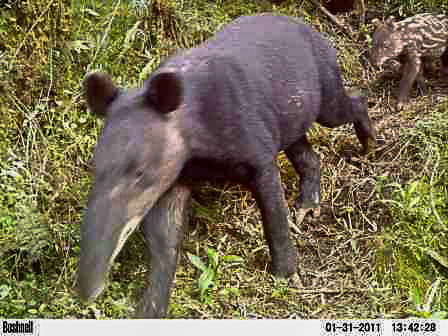Andean Tapir Conservation Project – PCTA

The Andean Tapir Conservation Project (PCTA), Mountain Tapir Conservation Project in the eastern slope of the central Andes of Ecuador, has been working since 2007, together with Zanja Arajuno, Ecominga Foundation and the IUCN Tapir Specialist Group. To generate distribution, population and ecological data of the mountain tapir in the Upper Pastaza River Basin, in the Ecological Corridor between the Llanganates and Sangay National Parks.
The PCTA aims to improve the protection and conservation of the Andean Tapir by monitoring the species and carrying out Environmental Education campaigns in the communities surrounding the Llanganates-Sangay Corridor, as well as direct actions for the conservation of its natural habitat, such as the Chamanapamba Reserve, located to the east of the Tungurahua volcano, which protects an important remnant of cloud forest and paramo forming a corridor to the Sangay National Park towards the Cerro Negro and Lagunas de Mintzas sectors.

Adult and hatchling in camera trap 
Monitoring of the mountain tapir (Tapirus pinchque) 
Night outing 
Camera trap installation 
Detail of a footprint 
Measurement of a footprint 
Tungurahua volcano erupting 
Mitza 
Avenue of the volcanoes at dawn
Some images and videos obtained during these 10 years of the project
Chamana Forest Reserve
The Chamanapamba Natural Reserve (RNC) was created in January 2010, as an initiative of biologists Marco Miguel and Juan Pablo Reyes Puig, together with Mr. Manuel Chapungal, a native of the area.
Our actions seek the protection of the cloud forest and water sources in the upper zone of the Chamana River, with 100 hectares dedicated to conservation, bordering the Sangay National Park through the Cerro Negro mountain range. The altitudinal gradient in the RNC is between 2500 and 3500 masl.
Thanks to self-management and small donations from friends, volunteers and collaborators of the Oscar Efrén Reyes Foundation, a scientific station has been built to house visitors, volunteers, students and researchers, as well as a room that will serve as a center for research, workshops, classes or even direct observations of flora and fauna in the surrounding forest.
Currently we have expanded approximately 15 hectares in the lower zone of the Reserve, thanks to the support of Fundación Ecominga.
To learn more, visit the EcoMinga Foundation web pages:





